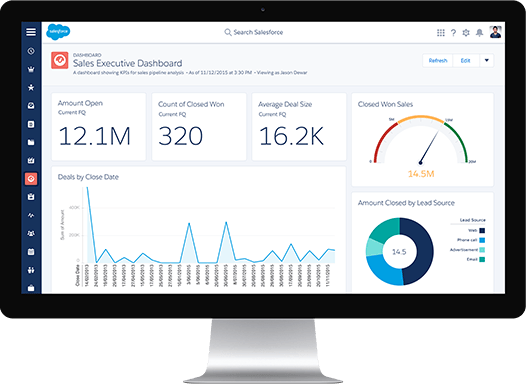Home / Services / Software Engineering / Platforms / Salesforce / Salesforce Implementation
Salesforce Implementation Services
A customized Salesforce implementation enables your Salesforce org to serve your specific requirements and connect to existing systems.
Successfully Launch or Relaunch Salesforce
Our Salesforce Implementations Usually Include:
- Customized User Interface
- Custom coding
- New user training
- New admin training
- Form validation
- Process automation
- Standard object configuration
- Custom object configuration
- Data modeling
- Security modeling
We will make Salesforce work for your business from day one. This mean that you will get a fully customized and ready-to-use Salesforce page that will accelerate your team’s productivity right away.

Are you a good fit for Salesforce implementation help?
Our complete Salesforce implementation plans and services are perfect if you’re launching for the first time, or if you need to re-implement Salesforce to increase functionality and usability.
And if you’re still not sure, let’s schedule a no-obligation, no-sale call and we’ll tell you if we think we can help.
Implementation At Every Stage
New | Re-Engineer | Recover
Our Salesforce implementation experts understand business goals and will work with you to launch your Salesforce org, or relaunch or recover your existing Salesforce org.
- New implementation is perfect if you’re starting with Salesforce for the first time.
- Re-Engineering projects will transform your existing Salesforce implementation together with your re-engineered business processes.
- Recovery projects will help you realize a higher return on investment (ROI) with your current Salesforce implementation, increasing usability, functionality, and adoption.
One of our core offerings is Salesforce customization, so no matter what your current situation is, our implementation services team can help!

We're Ready to Partner
Collaborate | Define | Execute
Our team will work closely with you to:
- Understand your goals, business challenges, and how your company operates
- Refine your obvious and hidden business processes
- Precisely define your Salesforce requirements
- Provide honest estimates and timelines
- Keep you well-informed
- Deliver your project on time and within budget
If you need any further SFDC customization, app development, or integration in the future, our team will always be here to help.

A Truly Agile Process
Plan | Learn | Improve
Working with us starts with discovery sessions, where we will begin to plan your Salesforce implementation as we understand your business, goals, and needs.
We encourage your users to test the implementation and provide honest feedback. Although we try to get it right the first time, there is almost always room for improvement. If something isn’t correct or can be improved, we will quickly update and fine-tune Salesforce, building an improvement stage into the process.

Scalable Cloud Solutions
Transformational Salesforce implementation for your growing business
Analytics Cloud
Unlock critical sales and service insights with Analytics Cloud. Consolidate, share and collaborate around your data instantly from any device or location. Create tasks and update records that drive action. With Analytics Cloud you provide employees and partners a real-time view into insights via reports and dashboards. Connect your Sales Cloud, Service Cloud, and Community Cloud data, and make checking on the health of your business easy and secure.
Community Cloud
You have been collecting information for years – now you’re thinking about how to make it work for you. Salesforce Community Cloud drives engagement with customers, partners, referral sources and any other constituents through customizable branded portals. Community Cloud connects you to the people you most want to cultivate and empower, bringing them closer to your business, and we all know an engaged customer is a long-term customer.
Service Cloud
Empower your company to provide world-class customer service more efficiently than ever before. Automate case management, create channels for customers, and streamline the support journey. Use Service Cloud to listen and respond to customers across social platforms – while drastically cutting costs. Combine this data with your Sales Cloud data to form a comprehensive picture of your customer.